The vast majority of hard floors can be brought back to life. On this page you will find a more in-depth description of each of the various processes that takes place during hard floor restoration.
It is important to understand, that the longevity of floor finishes and the floor itself, depends on the daily floor maintenance. The initial floor restoration and treatment is the first step, but it is just as important to develop a Floor Maintenance Programme that outlines the floor maintenance on a short, medium and long-term basis. This will ensure you get the most from your floor investment.
If you have any questions about our services or are curious to learn more, please don’t hesitate getting in touch with us, and we will be happy to help.
Deep Floor Cleaning
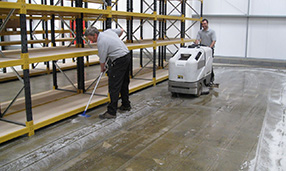
Our Deep Floor Cleaning service offers specialist floor cleaning on untreated floors. We carefully select the right products and methods to use according to the type of dirt and type of floor at your premises.
Over a period of time, the build up of dirt, grease and grime simply becomes too much for conventional floor cleaning methods and products to deal with, and you will need a deep clean to successfully restore your floor to a clean and hygienic condition.
If dirt and grit isn’t removed from your floor through effective floor cleaning, it will act as sandpaper and continuously abrade away, creating scratches and eventually break through the surface of your floor, calling for a premature floor replacement. Applying a polish to your floor will make cleaning easier and also protect its longevity.
The need for Deep Floor Cleaning is increased when the time available in the daily cleaning regime isn’t sufficient. Periods with high volume of traffic, wet weather conditions, the lack of effective entrance matting system etc., exposes your floor to more wear and tear than on sunny, dry days, where people spend more time outside.
The Deep Floor Cleaning service can be built into a Periodic Floor Maintenance programme. As an example, we will deep clean once every three months during the Spring/Summer, and once every two months during Autumn/Winter.

Strip & Seal
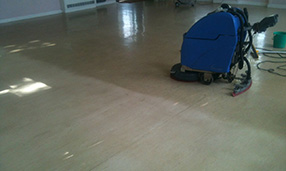 A Strip and Seal treatment is required when old polishes and sealers have become un-repairable and need to be completely removed from the floor before new coats can be applied. This treatment allows for a fresh start, and it is the perfect time to develop a thorough floor-cleaning programme to ensure the treatment lasts for a long time.
A Strip and Seal treatment is required when old polishes and sealers have become un-repairable and need to be completely removed from the floor before new coats can be applied. This treatment allows for a fresh start, and it is the perfect time to develop a thorough floor-cleaning programme to ensure the treatment lasts for a long time.
Examples of different situations that require a Strip and Seal treatment:
- When traffic has created walkways or other wear patterns on your floor and completely worn off the original polish.
- When new floors are installed, the insufficient factory finish will wear off quickly in high traffic areas much quicker than our specially developed hardwearing floor polishes.
- Incorrect floor sealing have sealed in the dirt and given your floor a dull and dirty look.
- Flaking floor polish due to contamination and lack of neutralising.
Once the floor polish has worn off, even if only in patches, a full Strip & Seal treatment is needed to bring the floor back to a healthy condition where it looks good and is easy to clean.
To avoid spending money unnecessarily on Strip and Seal treatments, our Periodic Floor Maintenance guarantees sufficient protection everywhere on your floor at all times, and allows your daily cleaning staff to carry on with their normal task of cleaning the floor.
Stripping and sealing floors should only be done by experienced professionals. Using the wrong chemicals, equipment and methods by inexperienced operators will not achieve the desired result and can easily stain and damage the floor, leading to costly repairs.

Scrub & Recoat
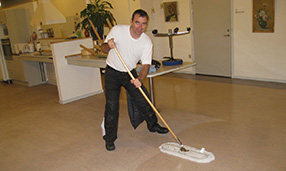 When normal wear and tear has started wearing off the top layers of floor polish, a Scrub & Re-coat will repair the finish and so the floor remains easy to clean. Sometimes this can be referred to as a ‘clean and re-seal’ or ‘deep scrub and re-seal’ but essentially it means to deep clean the floor according to the Scrub & Re-coat procedure and re-apply floor polish accordingly.
When normal wear and tear has started wearing off the top layers of floor polish, a Scrub & Re-coat will repair the finish and so the floor remains easy to clean. Sometimes this can be referred to as a ‘clean and re-seal’ or ‘deep scrub and re-seal’ but essentially it means to deep clean the floor according to the Scrub & Re-coat procedure and re-apply floor polish accordingly.
The Procedure, a simplified example:
- The floor in a corridor has originally been treated with 5 coats of polish.
- After a period of time normal traffic has worn off the top two coats (the 4th and 5th) and light scratches and embedded soil are present in the 3rd coat.
- During ‘deep scrub’, the damaged coat - in this example the 3rd – is removed.
- Because traffic patterns wear off the floor polish unevenly, our corridor will have 5 coats left on the edges, but only 3 coats left in the middle where all the traffic has flowed.
- After the ‘deep scrub’ there will be 4 coats on the edges and 2 coats left in the middle. Embedded dirt and light scratching are removed.
- A minimum of 3 coats are applied in the middle section of the corridor, 1 coat is applied along the edges.
- The floor has now been ‘cleaned up’, regained its original appearance and regular daily cleaning can carry on as normal.
Scrub & Re-coat treatments are used within a structured Floor Cleaning Programme and can only be carried out when layers of polish remains present on the floor and HAVE NOT been worn off anywhere.
Knowing how and when to repair finish is a skill that requires training and developing ‘an eye’ for. However, when carried out correctly, it will reduce the need for costly Strip & Seal treatments. Our Periodic Floor Maintenance programmes can include Scrub & Re-coat treatments at regular intervals to ensure sufficient floor protection everywhere on the floor to avoid traffic wearing through the polish and damage the floor itself.

Wood Floor Sanding & Sealing
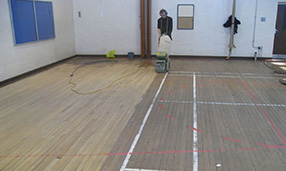 Being a natural material every wood floor is unique with its own shapes and patterns, and as a flooring material it is hard to match its individual beauty once it has been professionally sanded and sealed.
Being a natural material every wood floor is unique with its own shapes and patterns, and as a flooring material it is hard to match its individual beauty once it has been professionally sanded and sealed.
Our Wood Sanding service is carried out with the highest quality belt sanding and finishing sanding equipment in the business, and because we also use industrial dust extractors, our service is 99.9% dust free, so no mess is created. Before the sanding process, we will make small repairs and replace loose wood blocks if necessary.
When restoration is complete, we will advise you on the daily maintenance and make other recommendations that will make the floor finish last for as long as possible.
We highly recommend you screen sand and re-seal at regular intervals, so the traffic doesn't wear off the finish. Once the finish has worn off, even just in places, full belt sanding and sealing is required again. See our Periodic Floor Maintenance service for more information.

Periodic Floor Maintenance
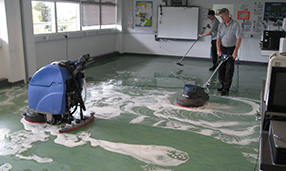 If you only want to focus on the basic daily floor cleaning yourself but still want your floors to remain in a tip-top condition at all times, Periodic Floor Maintenance enables you to do that.
If you only want to focus on the basic daily floor cleaning yourself but still want your floors to remain in a tip-top condition at all times, Periodic Floor Maintenance enables you to do that.
Covering a wide range of floor treatments, this is a maintenance programme individually developed to suit your business. Unique Floorcare periodically carries out the particular service you require to keep your floors in the condition you want them. All you will have to do is to carry out the daily floor-cleaning yourself. We will even create an Individual Floor Cleaning Programme with instructions of how you or your cleaning contractor should clean your floor most effectively.
Due to time constraints, turnover of staff, lack of resources, inexperience etc, it is very rare that a facility can realistically carry out periodic floor cleaning themselves in line with the recommended methods without any help.
Periodic Floor Maintenance is a service particularly suited for businesses who realise their floor is an asset that need looking after properly:
- Education facilities, with a high turnover of cleaning staff, or staff with a number of different tasks other than cleaning.
- A small retail outlet may not require a cleaning contractor on a daily basis, but are aware of the image its floor projects to its customers
- Supermarkets with a high traffic flow will need to have floors that can be cleaned easily.
- Cleaning companies without practical experience, product and floor knowledge, will save time and money because they can focus on what they’re good at, namely organising staff and carrying out the large number of more common cleaning tasks
- Business owners who want their newly fitted floors maintained properly from day one.

Ultra High Speed Burnishing
-SupBrugs-After2-286.jpg) Once your floor has been sealed and polished, regular burnishing can be carried out to further enhance the look of your floor and extend the life of the floor finish. This is particularly suitable for high traffic areas where a high gloss ‘wet look’ is desired.
Once your floor has been sealed and polished, regular burnishing can be carried out to further enhance the look of your floor and extend the life of the floor finish. This is particularly suitable for high traffic areas where a high gloss ‘wet look’ is desired.
Using an Ultra Higher Speed burnishing machine (min 1500rpm) with the appropriate white or blue floor-burnishing pad, this method can instantly restore the gloss to a floor where traffic has created light scratches in the polish.
First, the floor will be thoroughly vacuumed or dust mopped to remove soil particles that otherwise will scratch the coating or floor covering.
Following the dry dust removal the floor is cleaned with a pH neutral cleaning solution or a cleaner/restorer as appropriate. Burnishing starts when the floor is completely dry.

Concrete Grinding & Polishing
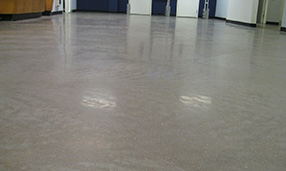 This is the first step of restoring a stone floor with extreme faults such as lippage and deep scratches. Lippage is when the floor tiles on either side of a grout line are of different height, giving the floor an uneven appearance.
This is the first step of restoring a stone floor with extreme faults such as lippage and deep scratches. Lippage is when the floor tiles on either side of a grout line are of different height, giving the floor an uneven appearance.
Coarse metal bond diamond abrasives are used in the first ‘cut’ to remove lippage and deep scratches leaving a smooth and evenly honed surface, ready for Diamond Polishing.
When the pores of the concrete have been opened up, usually in the early stages of polishing with resin bond, we apply a densifier to make the floor denser and harder. This will close the porosity of the floor and make it easier to clean.
Ultra-high speed burnishing with diamond impregnated floor pads can be used as the final step to achieve a very high gloss finish.

Natural Stone Cleaning & Polishing
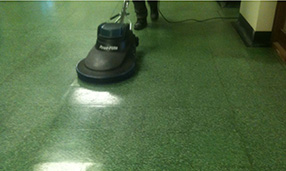 As with Concrete Grinding & Polishing, the removal of deep scratches and lippage between floor tiles is the first consideration when restoring natural stone floors. This step is carried out with coarse metal bond diamonds and leaves you with a good base to work from before progressing to honing the stone.
As with Concrete Grinding & Polishing, the removal of deep scratches and lippage between floor tiles is the first consideration when restoring natural stone floors. This step is carried out with coarse metal bond diamonds and leaves you with a good base to work from before progressing to honing the stone.
The honing process removes light scratching and ‘cleans up’ a dirty looking floor by removing the very top layer of the stone with medium grade diamonds. Honing will leave the floor with its natural look with a matte finish.
If a high gloss look is desired we will proceed with Diamond Polishing. During this the process, polishing with progressively finer grades of resin bond diamonds will produce a high shine on the floor. Each polishing step will remove the scratches left by the previous step. The number of steps needed depends on the desired finish, i.e. a high gloss finish demands more polishing steps than a low gloss finish. Ultra-high speed burnishing with diamond impregnated floor pads is the last step when producing a very high gloss finish.

Stone Crystallisation / Vitrification
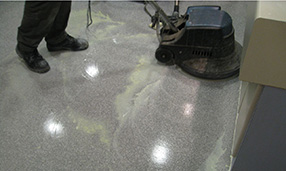 On stone floors such as Marble and Terrazzo that contain calcium carbonate, a polishing powder is worked into the floor using a low speed rotary floor scrubber and polishing pad. The process enables acid content to break down the bond between the calcium and the carbonate and form calcium fluorosilicate and produces a very high shine. It creates an impervious and often a harder surface making the floor more resistant to staining and improves maintenance results.
On stone floors such as Marble and Terrazzo that contain calcium carbonate, a polishing powder is worked into the floor using a low speed rotary floor scrubber and polishing pad. The process enables acid content to break down the bond between the calcium and the carbonate and form calcium fluorosilicate and produces a very high shine. It creates an impervious and often a harder surface making the floor more resistant to staining and improves maintenance results.
For years experts have debated whether the quicker process of Crystallisation is better than traditional Natural Stone Polishing. We will discuss both options with you before we start any work to make sure you get what you want.

Individual Floor Cleaning Programmes
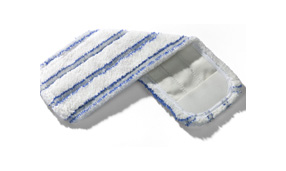
We provide Individual Floor Cleaning Programmes to all of our clients after we have restored their floor.
This programme serves as a guide of how to carry out your daily floor cleaning most effectively, and it includes recommendations for products, methods, dilution ratios and cleaning frequencies to use, etc.
It doesn't matter if your facility is large or small, or if you currently use mops & buckets or ride-on scrubber dryers; we will make our recommendations on an individual basis to help you optimise your daily cleaning based on your type of facility, traffic, equipment and methods currently in use.
60% of all cleaning time is spent on floor maintenance alone, but even though great products and new cleaning methods have been developed, many facilities haven't caught up yet.
We can show you small alterations in your daily floor cleaning that will improve results instantly.

Free Site Survey and Demonstration
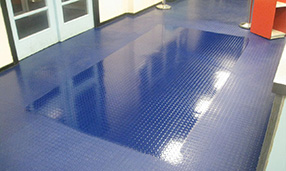
If you are unsure of the best way to proceed with your floor restoration, we offer a free site survey to determine the correct method of restoring your floor to its original shine.
We will complete a thorough fact finding questionnaire that will allow us to decide on the most appropriate and cost effective restoration and cleaning process for your floor.
We will also carry out a free demonstration on a small section of your floor, to enable you to make a “before and after” comparison to see the many benefits of our floor restoration process, including the exquisite finish, the improved longevity and the ease of daily cleaning.

After Care and Advice
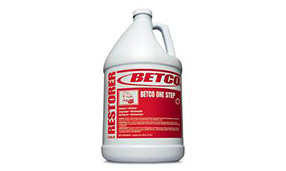
After investing in the restoration of your floor it is important to ensure you get the most benefit from your investment. Therefore within six weeks of the completion of the restoration we will contact you to find out how your new floor is performing and if you have any questions about our recommended floor cleaning programme.
It is important to understand that the longevity of your floor finish depends on how well it is maintained, and our aftercare and advice aims to answer any questions you may have regarding protecting your floor.
We are happy to demonstrate floor-cleaning techniques and to train your staff to achieve the very best protection for your floor.
